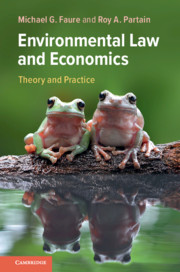Book contents
- Environmental Law and Economics
- Environmental Law and Economics
- Copyright page
- Contents
- Preface
- Acknowledgements
- Abbreviations
- 1 Introduction
- 2 Environmental Harm and Efficiency
- 3 Property Rights Approach to Environmental Law
- 4 Environmental Standard Setting
- 5 Principles of Environmental Law and Environmental Economics
- 6 Pricing Environmental Harm
- 7 Market-Based Instruments
- 8 Liability Rules
- 9 Environmental Regulation
- 10 Environmental Crime
- 11 Insurance for Environmental Damage
- 12 Compensation for Environmental Damage
- 13 Environmental Federalism
- 14 The Role of Environmental Law in Developing Countries
- 15 Epilogue
- References
- Index
9 - Environmental Regulation
Published online by Cambridge University Press: 13 September 2019
- Environmental Law and Economics
- Environmental Law and Economics
- Copyright page
- Contents
- Preface
- Acknowledgements
- Abbreviations
- 1 Introduction
- 2 Environmental Harm and Efficiency
- 3 Property Rights Approach to Environmental Law
- 4 Environmental Standard Setting
- 5 Principles of Environmental Law and Environmental Economics
- 6 Pricing Environmental Harm
- 7 Market-Based Instruments
- 8 Liability Rules
- 9 Environmental Regulation
- 10 Environmental Crime
- 11 Insurance for Environmental Damage
- 12 Compensation for Environmental Damage
- 13 Environmental Federalism
- 14 The Role of Environmental Law in Developing Countries
- 15 Epilogue
- References
- Index
Summary
Law and Economics views the operation of private and public law as complementary, best seen as two aspects of a joint mechanism to guide actors in their environmental behaviours. This is a mechanism design technique from game theory, often referred to in popular press as ‘smart mixes'. Liability rules have their limits. Perhaps most noteworthy is that you have no case until you are already injured, thus civil liability rules are not optimal. Public regulations can monitor behaviour prior to an accident. Public regulation has a more diverse set of governance tools, including criminal law and incarceration. Public regulation is not free from its own problems. Agency capture and deflection of regulatory drafting are major concerns. Private regulatory mechanisms are programmess wherein public authorities design mechanisms that engage several private parties, all related to the environmentally risky activity, to create new interactions that both reveal more data and alter private behaviour to align with public regulatory goals. The story of environmental Law and Economics is not a tale in defence of private law rights against public law regulation, but rather a harmonious tale of two systems that can be integrated to function as a more effective and efficient whole.
Keywords
- Type
- Chapter
- Information
- Environmental Law and EconomicsTheory and Practice, pp. 182 - 210Publisher: Cambridge University PressPrint publication year: 2019



